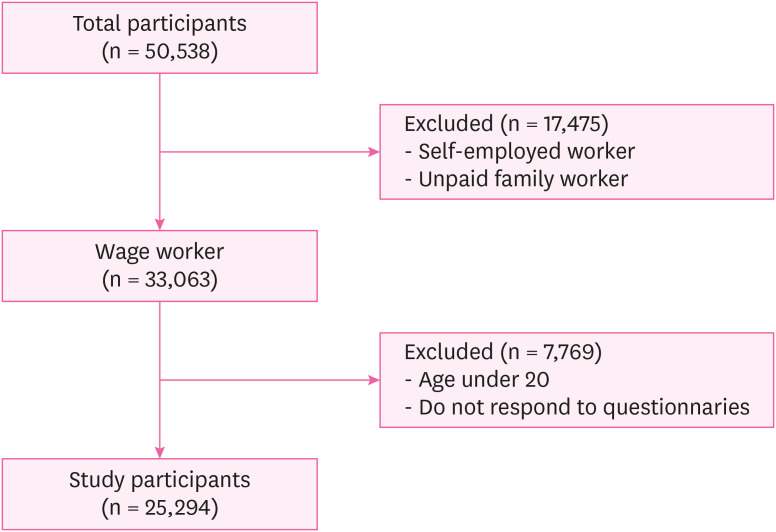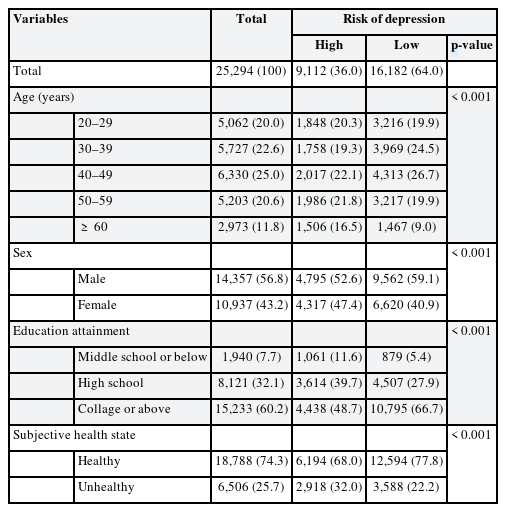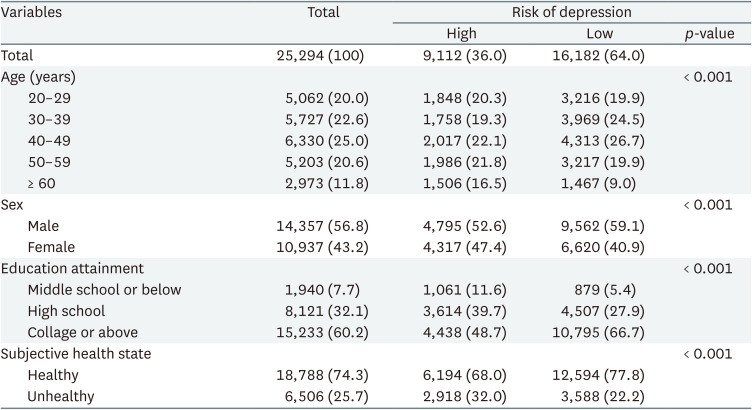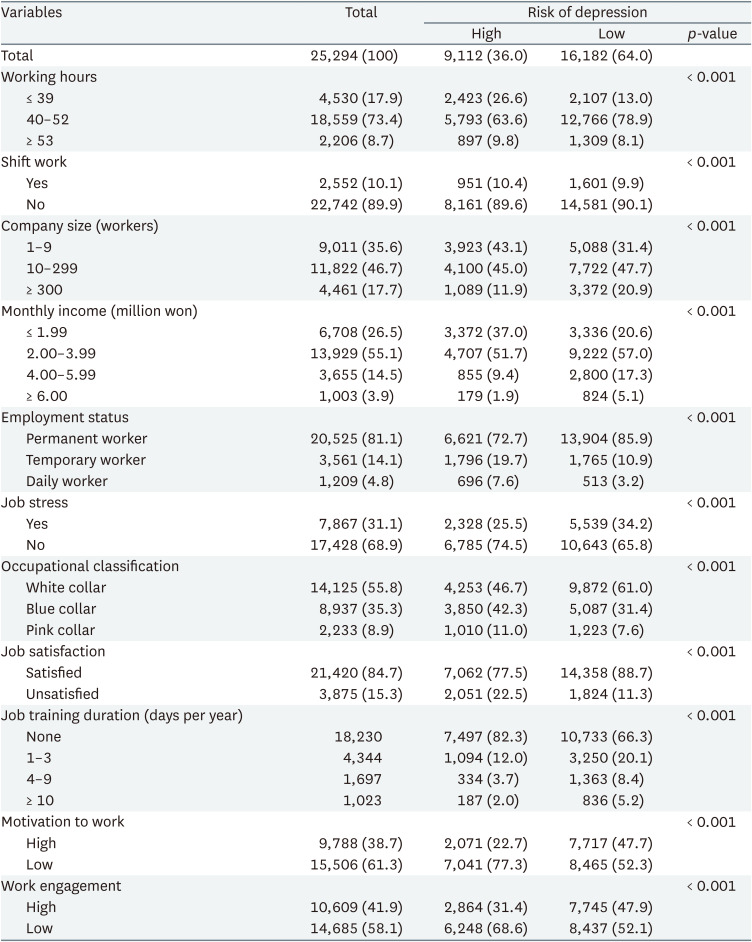The association of job training duration and risk of depression among wage workers: an analysis of the mediating factors
Article information
Abstract
Background
Research on job training and job satisfaction has been conducted from various perspectives. Job training is thought to be associated with job satisfaction, which is known as an important factor for depression among workers. We hypothesized that job training duration could influence depression through potential mediators (job satisfaction, motivation to work, and work engagement).
Methods
This study encompassed participants from the sixth Korean Working Conditions Survey (KWCS), conducted between 2020 and 2021. To show the relationships between demographic or occupational characteristics and risk of depression, a χ2 test was conducted. The association between job training duration, potential mediators, and risk of depression was analyzed by constructing multiple logistic regression models. The mediating effects of potential mediators on job training duration and risk of depression was evaluated with flexible mediation analysis with weighting-based methods.
Results
The final study population consisted of 25,294 participants. Longer job training duration significantly decreased risk of depression after adjusting for confounders. In the group that received the longest job training duration (≥ 10 days), compared with the group without job training, the odds ratio (OR) for high risk of depression was 0.46 (95% confidence interval [CI], 0.39–0.54). Each three potential mediators showed statistically significant indirect effects and direct effect. Although indirect effects were not strong compared to direct effect, motivation to work had the strongest mediating effect in this study, with an OR of 0.94 (95% CI, 0.92–0.95).
Conclusions
Job training duration was found to have a statistically significant negative association on the risk of depression, and three mediators partially mediating this effect. Although the mechanism was unknown, our findings suggest that job training has a positive influence on workers' mental health. Furthermore, by suggesting the possibility of other pathways existing between job training and depression, we provide directions for future research.
BACKGROUND
Historically, extensive studies have been conducted on the impact of job training. These have found that ongoing job training results in significant benefits for current employees, including wage increases and longer tenure.1234 These positive effects emerged regardless of the company’s size or the type of job training provided. Furthermore, increased duration and high-quality job training have been shown to increase job satisfaction56789 and boost productivity.10 Particularly, those who strongly perceived the necessity of training exhibited even more pronounced positive outcomes.8
However, most studies on job training have focused on its economic impact; the relationship between job training and mental health remains largely unexplored. Depression is a health concern for workers and is known to cause occupational issues such as increased workplace accidents, decreased productivity, frequent absenteeism, and early retirement.1112 In addition to the association between job satisfaction and job training, an association between job satisfaction and mental health has been also noted. Studies by Ahn and Park13 and Park and Park,14 found a significant correlation between increased job satisfaction and reductions in depression as well as overall improvements in mental health. Janyam15 and Zhang and Chai16 indicated that job satisfaction is related to mental health issues such as depression, anxiety, and sleep disorders, possibly serving as a protective factor against depression and can mitigate negative mental health effects.
Other previous studies suggest that occupational factors such as “motivation to work,” “work engagement” have a significant correlation with job training1718 and depression.1920 Haryono et al.17 research the relationship between job training and motivation to work, and Sendawula et al.18 studied the relationship between job training and work engagement. Their findings demonstrated that job training enhances both motivation to work and work engagement, consequently leading to improved job performance. Additionally, Meng and Yang,19 as well as Innstrand et al.20 conducted studies on the relationships between motivation to work and depression, and between work engagement and depression, respectively. Their research showed statistically significant findings: a decrease in motivation to work is associated with an increase in depression, while an increase of work engagement is correlated with decrease in depression. Also, according to previous research of the Korean Working Conditions Survey (KWCS), “motivation to work” and “work engagement” are associated with mental health issues such as emotional vitality and sleep disorder, along with job satisfaction.21
Based on previous research outcomes that demonstrate the positive influence of job training on job satisfaction and the subsequent link between job satisfaction and mental health, as well as the factors of motivation to work and work engagement, this study sought to empirically verify the hypothesis that job training may be associated with mental health, possibly mediated by these factors. By analyzing these mediating effects, this study seeks to enhance the explanatory power of the relationship between job training and depression.
METHODS
Study participants
This study used data from the sixth KWCS, conducted by the Korea Occupational Safety and Health Agency in 2020.22 Using a multistage random sampling method based on the results of the 2018 Population and Housing Census, 50,539 individuals were finally selected. Data were collected through face-to-face interviews at respondents’ residences using structured questionnaires. The survey included questions related to occupational and environmental hazards. It provides raw data to facilitate research and improve work conditions.23 Additionally, KWCS provides the weights for the research group to ensure representation of the entire population.
Main variables
Job training duration
From the survey items, respondents who answered “none” to the question, “Did your employer provide or cover the costs of training?” were categorized as “none.” Those who responded affirmatively were further classified based on their responses to a subsequent question regarding the duration of the training they received: “1–3 days,” “4–9 days,” and “≥ 10 days.”
Job satisfaction
For the survey question, “Overall, how satisfied are you with your working environment?” respondents who answered “very satisfied” or “satisfied” were grouped under “Satisfied,” whereas those who responded with “not very satisfied” or “not satisfied at all” were categorized as “Unsatisfied.”
Motivation to work
For the survey question, “The organization where I work motivates me to give my best job performance,” respondents rated their answers on a 5-point scale (0–4). Score above 2 were classified as high motivation to work (“High”), score 2 or below were classified as low motivation to work (“Low”).
Work engagement
Utrecht Work Engagement Scale (UWES) serves as an evaluative measure of work engagement. The Korean version of the UWES has acceptable reliability and validity in prior research24; therefore, in this study, UWES scores were used to measure work engagement. Respondents rated their answers on a 5-point scale (0–4) for each of three items: “At my work, I feel full of energy,” “I am enthusiastic about my job,” “Time flies when I am working,” The total score can be used to represent work engagement. Score 6 or above were classified as high work engagement (“High”), below 6 were classified as low work engagement (“Low”).
Risk of depression
The World Health Organization’s (WHO) WHO-5 Well-Being Index (WHO-5) serves as an evaluative measure of mental well-being and ranks among the most prominent questionnaires used to assess subjective psychological welfare.25 It can also function as a screening tool for depression,26 boasting reliability comparable to the Patient Health Questionnaire-9 (PHQ-9) and marginally higher sensitivity.2728 Furthermore, the Korean version of WHO-5 index demonstrated high reliability.29
Respondents rated their feelings on a 6-point scale (0–5) for each of five items: pleasurable and positive mood, calmness and tranquility, vigor, refreshment in the morning, and engaging in daily life. The total score, with a maximum of 25 points, is converted proportionally to a scale of 100. According to previous studies, a score below 50 is considered indicative of depression. The reliability is high compared to the other depression screening tool, such as Hamilton Depression scale (HAMD).262930 Therefore, in this study, scores below 50 were classified as low risk of depression (“Low”), whereas scores of 50 and above were classified as high risk of depression (“High”).
Confounders
Among the factors reported in previous studies that influence job satisfaction and depression, those ascertainable from the KWCS were adopted as confounders. Prior studies on job satisfaction have indicated the presence of intrinsic313233 and extrinsic34 factors. Given the constraints of the KWCS survey items, we adopted primarily extrinsic factors: educational attainment, job security, job stress, working environment, shift work, and monthly income. Working environment was based on working hours and company size. Factors such as genetics, underlying diseases, lifestyle, and economic reasons have been noted to influence depression. However, in this study, we adopted sex, age, subjective health status, monthly income, and job stress as significant determinants.353637 Elements influencing either one or both variables were selected as confounders. Moreover, occupational classification (white, blue, pink collar) was also considered a potential influencing factor and hence was selected as a confounder.
Sociodemographic characteristics
The respondents were categorized by sex, age (20–29, 30–39, 40–49, 50–59, ≥ 60), educational attainment (middle school or below, high school, college or above), and subjective health status (healthy, unhealthy).
Occupational characteristics
Classifications were made based on working hours (≤ 39 hours, 40–52 hours, ≥ 53 hours), the presence of shift work, monthly income (≤ 1.99, 2.00–3.99, 4.00–5.99, ≥ 6.00 million won), employment status (permanent, temporary, daily worker), company size (1–9 workers, 10–299 workers, ≥ 300 workers), presence of job stress, and occupational classification (white, blue, pink collar).
Statistical analysis
The sampling weight provided by the KWCS were considered for analysis, except mediation analysis since there is no commercial or publicly opened package for mediation analysis with sampling weight.
A χ2 test was used to analyze the association between respondent characteristics, potential mediators (job satisfaction, motivation to work, work engagement), and depression. Then, multiple logistic regression analysis was performed, with job training duration as independent variable, the risk of depression and potential mediators as a dependent variable, adjusting confounders. Then, a multiple logistic regression model was calculated with job training and potential confounders as independent variables, the risk of depression as dependent variable. Odds ratios (ORs) were calculated, adjusted for confounders.
The mediating effect of job satisfaction, motivation to work, and work engagement on the length of job training duration and the risk of depression was evaluated with flexible mediation analysis with weighting-based method, applying logit link function for both mediator and outcome. Standard errors and 95% confidence interval (CI) were calculated by non-parametric bootstrap method with corresponding Wald-type z statistics and p-values.
SPSS version 21.0 (IBM corporation, Armonk, NY, USA) was used for the descriptive statistics, univariable analysis and logistic regression with sampling weight. For mediation analysis, R-4.3.2 (http://www.r-project.org) with package “medflex” was used.
Ethics statement
This study was exempt from the ethical approval by the Institutional Review Board of Yeungnam University Hospital (IRB No. 2023-10-030).
RESULTS
Of the 50,538 individuals surveyed in the KWCS, 17,475 were excluded because they were non-wage workers and another 7,769 were excluded due to non-response to the relevant survey items. Therefore, the final study population consisted of 25,294 individuals (Fig. 1).
Table 1 shows the relationship among demographic characteristics and risk of depression. There is a demonstrated escalation in the prevalence of a high risk for depression correlating with advancing age, particularly evident in the male demographic. Risk of depression was less common among those with higher education and those who perceived their health to be good.
Table 2 shows the relationships among occupational characteristics and risk of depression. Those who worked 40–52 hours per week, did not work shifts, permanent worker, worked white-collar jobs, and did not experience job stress had a lower risk of depression. Moreover, individuals with higher monthly incomes and those working in larger businesses exhibited lower risk of depression.
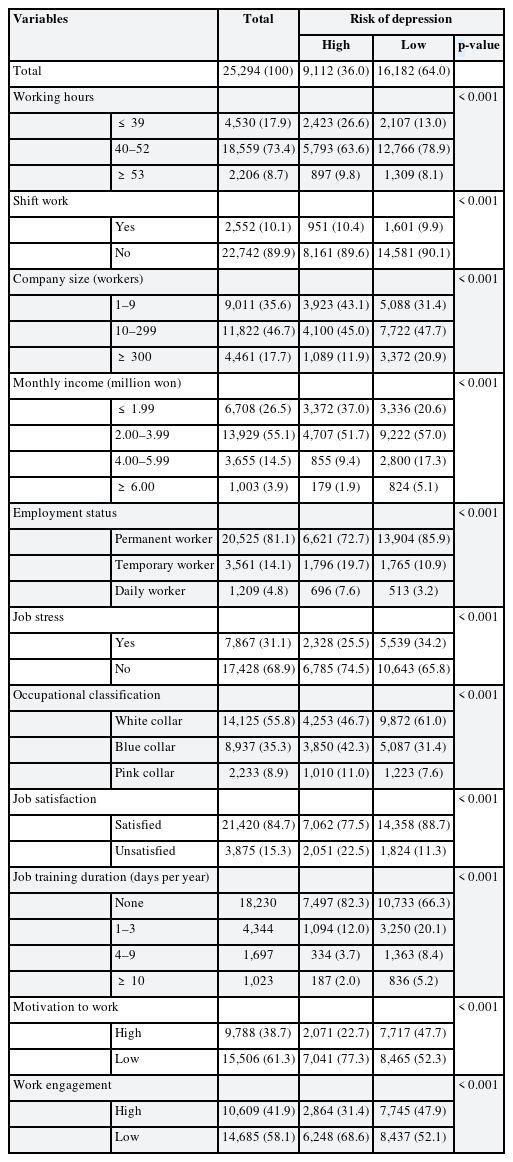
Occupational characteristics including job satisfaction, motivation to work, and work engagement of participants by risk of depression
Table 3 presents the relationship between job training duration, mediating factors and risk of depression, adjusting all confounders. Using the group without job training as a reference, the OR and 95% CI for job satisfaction and work engagement were highest in the group with more than 10 days of job training, with ORs of 1.69 (95% CI, 1.33–2.13) and 1.33 (1.17–1.52), respectively. Motivation to work was highest in the group that received 4–9 days of training, with an OR of 1.38 (95% CI, 1.23–1.53). Risk of depression was lowest in the group with more than 10 days of job training, with an OR of 0.46 (0.39–0.54), and all these findings of table were statistically significant in all cases. Supplementary Table 1 examined the relationship between job training duration and risk of depression, treating all mediating factors as covariates. The impact of motivation to work was found to be the strongest among those factors, with an OR of 0.64 (95% CI, 0.62–0.69).
Table 4 shows the direct relationship between job training duration and risk of depression and the mediating effect and percentage of indirect effect driven by job satisfaction and the other two factors, motivation to work and work engagement. The mediating effects were all statistically significant, indicating a decreased risk of depression. Job satisfaction showed the strongest mediating effect in the group with the longest job training duration, while mediating effect of motivation to work and work engagement were most pronounced in the group with the shorter job training duration. Using the group without job training as a reference, the indirect effect of job satisfaction was 0.98 (95% CI, 0.97–0.99) in the group that received the longest job training, for motivation to work, it was 0.94 (95% CI, 0.92–0.95), and for work engagement, the indirect effect was 0.97 (95% CI, 0.95–0.98) in the group with the least training. The percentage contribution of indirect effects was less than 10% in almost all cases. Percentage of motivation of work in group with 1–3 days of job training was the highest, at 15.85%.
DISCUSSION
In this study, we utilized the results from the KWCS data to investigate the association between job training duration and risk of depression in Korea. While previous research has extensively studied the economic benefits of job training, this study aims to explore the impact of job training on depression. Furthermore, it seeks to uncover the mechanisms by analyzing the mediating effects of job satisfaction, motivation to work, and work engagement, which are among the occupational factors known to influence depression according to various studies.
These findings are in line with prior research on the relationship between job training and job satisfaction. In a study conducted by Kim,5 the impact of job training on organizational performance was investigated and results indicated that job training exerts a positive correlation on both job satisfaction and job competency. Studies by Schmidt6 on technical service workers and Chiang et al.7 on hotel industry workers have also demonstrated a positive correlation between job training duration and job satisfaction, and job training method is also correlated with job satisfaction. Vasudevan8 studied the relationship between job training factors (training commitment, training needs assessment, training contents, training evaluation) and job satisfaction, and all job training factors were found to have a positive impact on job satisfaction. Haryono et al.17 conducted a study involving 215 employees from the Department of National Education in Indonesia, aiming to explore the relationship between job training, motivation to work, job promotion, and the mediated effect on job performance. Their findings indicated that both job promotion and motivation to work are significantly positively correlated with job training, and motivation to work showing a stronger association. Sendawula et al.18 carried out research with 150 employees in the health sector of Uganda, investing the relationship between job training and work engagement, and the mediated effect on job performance. This study concluded that there is a significant positive correlation between job training and work engagement.
Regarding the association between job satisfaction and depression, Ahn and Park13 reported that job satisfaction had the strongest correlation with depression among health care workers. Aazami et al.38 showed that job satisfaction negatively impacted depression and anxiety in female public-sector workers in Malaysia, while Faragher et al.39 conducted a meta-analysis of various studies carried out in several countries, which indicated an association between job satisfaction and burnout, depression, and anxiety. Zhang and Chai16 targeted randomly selected migrant workers, also finding that increased job satisfaction reduced depression.
In previous studies on motivation and depression, Meng and Yang19 conducted a study on 5,025 Chinese manufacturing workers, showed a significant negative association between motivation to work and depression. Luo40 researched 300 Taiwanese workers, revealing an association between motivation to work and depression, as well as job satisfaction. Innstrand et al.20 investigated the relationship between work engagement and depression and anxiety in 3,475 participants with various occupations in Norway. They found that work engagement is significantly associated with depression and anxiety, suggesting that work engagement is more likely an antecedent rather than an outcome of depression and anxiety. Imamura et al.41 studied the association between work engagement and major depression episodes in 1,058 employees of a think tank company in Japan, showed a significant negative association.
Previous studies examining the relationship between job training and mental health have been quite limited. Shin et al.42 examined the relationship between job training and mental health by categorizing it based on the needs of job training, as well as work creativity. They found that job training had a positive effect on mental health within groups characterized by high work creativity and those who were unskilled (indicating a need for job training). However, excessively prolonged job training had an adverse effect on mental health. In another study, Belloni et al.43 conducted a study on the association between job quality (physical environment, working time, work intensity, skills and discretion, and job prospects) and mental health. The dimension of skills and discretion, which includes job competence and job training, was found to exert a statistically significant and positive effect on reducing anxiety and depression. The two aforementioned studies posit the potential role of job satisfaction as a mediating factor between job training and mental health, although this hypothesis has not been verified. To date, no studies have been conducted on the potential mediating role of motivation to work and work engagement in the relationship between job training and depression. However, given the established strong associations between job training and both motivation to work and work engagement, as well as significant relationship of these factors with depression, it was hypothesized that they could act as mediators. Therefore, in this study, we explored motivation to work and work engagement as mediating factors, along with job satisfaction, in the association of job training duration and risk of depression.
We analyzed the association between job training duration and risk of depression. We observed a significant decrease in risk of depression in all cases, particularly in the crude group. This result suggests that although there may be factors not included in this study due to limitations in the survey content, the fact that the risk of depression in the group with the longest job training duration showed an OR of 0.46 (95% CI, 0.39–0.54) even after controlling the demographic and occupational characteristics using the untrained group as a reference, job training functions to reduce the risk of depression.
We also examined the association between job training duration and risk of depression and the mediating effect of job satisfaction and other factors. Although all mediating factors statistically significantly reduced the risk of depression, indirect effects of these factors were insufficient to demonstrate the pathway between job training duration and risk of depression. In this analysis, the largest indirect effect was seen in motivation to work, OR of a 0.94 (95% CI, 0.92–0.95) with the shortest job training group. Based on prior studies, we hypothesized that job training and depression would be significantly associated, with job satisfaction, motivation to work, and work engagement acting as mediating factors. Indeed, these factors were statistically significant in their mediating effects. However, contrary to our expectations, the mediating effects of these factors were not substantial, and the direct effects remained significant. Consequently, this study was able to present some of the pathways influencing the relationship between job training and depression, suggesting the possibility of additional pathways. These can be further investigated in future research.
This study has several limitations. First, as a cross-sectional study, causality was not clarified. Observing changes in the same participants before and after the training would have enhanced the study’s validity. Second, the KWCS survey items were limited. While factors such as job satisfaction and job stress typically require multiple survey items for accurate evaluation, our study relied on single item indicators, leading to potential validity concerns. Also, quality of job training was not included in KWCS survey items, and we could only assess based on the job training duration. Third, personal health issues that could impact depression, such as underlying diseases, alcohol consumption, and smoking, were not considered. Fourth in our study, the WHO-5 index, originally not intended for the diagnosis of depression, was employed as an operational tool for defining and classifying depression as the outcome variable. While the reliability of the WHO-5 index is better in comparison with the other screening tool, such as HAMD, comparisons with DSM-V or ICD-11 used clinically in Korea have not yet been conducted. However, using the WHO-5 index as an indicator for depression in research is a widely mused method, previously employed in numerous studies.4445 Finally, the indirect effects of mediating factors in this study were weak. There may be other factors with strong indirect effects that could not be included in this study as they were not part of the KWCS survey items.
This study's strengths are its large sample size and wide range of occupations compared to previous studies, which often had fewer than 500 participants131415 or focused on a specific occupational group.5738 Using KWCS data enabled us to include a diverse range of participants. Although causality was not established, this study highlights the role of job training in enhancing job satisfaction, which is related to depression. It also provides a direction for future research to elucidate the causal relationships and explore other mental health dimensions, such as anxiety.
CONCLUSIONS
This study found a negative association between job training duration and risk of depression. As job training duration increased, there was a significant enhancement in job satisfaction and a noticeable reduction in the risk of depression. Job training duration was found to maintain a significant direct effect on the risk of depression, even when considering various mediators in the analysis. Although the mediating effects of job satisfaction, motivation to work, and work engagement were weak, they were statistically significant in mediating the relationship between job training and depression. Beyond the implications for productivity and skill development, this research suggests the potential benefits of job training for workers' mental health, and it implies the necessity for further research on job training, revealing other potential positive effects, and advocating for its expansion to benefit a broader range of workers.
Notes
Competing interests: The authors declare that they have no competing interests.
Author contributions:
Conceptualization: Baek K.
Data curation: Kim DG.
Formal analysis: Kim DG, Baek K.
Funding acquisition: Baek K.
Investigation: Kim DG, Kim DK.
Methodology: Baek K.
Software: Kim DK, Baek K.
Validation: Kim DK, Baek K.
Visualization: Kim DK, Baek K.
Writing - original draft: Kim DG, Kim DK.
Writing - review & editing: Kim DK, Baek K.
Abbreviations
CI
confidence interval
HAMD
Hamilton Depression scale
KWCS
Korean Working Conditions Survey
OR
odds ratio
PHQ-9
Patient Health Questionnaire-9
UWES
Utrecht Work Engagement Scale
WHO
World Health Organization
WHO-5
WHO-5 Well-Being Index
References
SUPPLEMENTARY MATERIAL
Supplementary Table 1
Multiple logistic regression model of risk of depression, job training duration, and potential mediators

